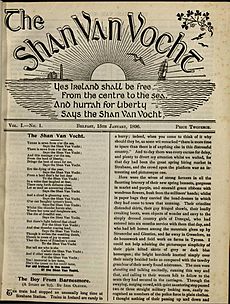The Shan Van Vocht facts for kids
The Shan Van Vocht is an old Irish phrase. It means "The Poor Old Woman." This phrase became famous in Ireland. It was the name of a song from the 1798 Irish rebellion. The song was seen as rebellious. Later, in the 1890s, it became the title of a popular book. It also named a magazine that supported Irish independence. Both aimed to honor the United Irishmen. This group wanted Ireland to be a republic. They did this during a time when people disagreed about Home Rule. Home Rule meant Ireland would govern itself.
The Shan Van Vocht Song
The song "The Shan Van Vocht" is very old. People first mentioned it in 1797. It talked about the French army coming to help Ireland. The song said Irish troops would wear green. They would fight for freedom.
Written versions of the song appeared in the 1820s. People used it during campaigns led by Daniel O'Connell. He fought for Catholic Emancipation. This meant Catholics could have more rights. Later, he wanted to bring back an Irish parliament. This was called the Repeal movement. It aimed to undo the Acts of Union of 1800. These acts had joined Ireland and Great Britain. A politician named A. A. Sullivan said the song was very popular. He noted that poets often used it in Irish elections.
A Famous Novel
In 1885, a newspaper called the Weekly News published a story. It was a novel by James Murphy. The novel was called The Shan Van Vocht: the story of the United Irishmen. It reminded people about the song's link to the 1798 rebellion.
The story takes place in October 1798. It is set during the French expedition to Lough Swilly. This was in County Donegal. The book tells about the death of Theobald Wolfe Tone. He was a leader of the United Irishmen. The novel became very popular. It was printed many times.
A Nationalist Magazine
In 1896, Alice Milligan and Anna Johnston started a magazine. They lived in Belfast. They named their monthly magazine The Shan Van Vocht. It cost two pence. The magazine was similar to an older Irish newspaper. It had poems, stories, and Irish history. It also included political articles and news.
The first issue came out in January 1896. Its cover explained the title. It said the "Poor Old Woman" was a symbol for Ireland. The magazine's motto was a line from the song. It said: "Yes Ireland shall be free, from the centre to the sea, and hurrah for liberty says the Shan van Vocht". This showed their hope for an independent Ireland.
The magazine published forty issues. In 1899, Milligan and Johnston stopped publishing it. They gave their list of subscribers to Arthur Griffith. He started a new newspaper in Dublin. It was called the United Irishman. This newspaper was linked to Cumann na nGaedheal. This group later became Sinn Féin.
See also


